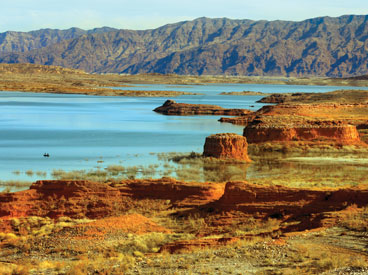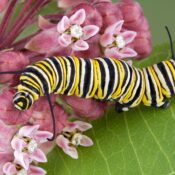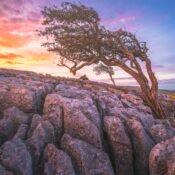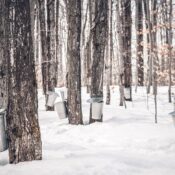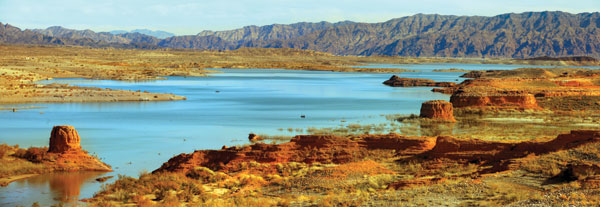
Kylan Frye steers her Subaru station wagon along the slushy roadways of the Farmington Bay Waterfowl Management Area at the edge of Utah’s Great Salt Lake. It’s a February afternoon, gray and cold, and a layer of snow covers the wetlands that spread for miles around us. The Wasatch Range rises ruggedly in the background, but otherwise it feels like we’re driving through a barren white sea, indistinguishable from the pale sky if not for the occasional dots of sagebrush, sedge, and cottonwood. The air is thick with gull calls and the periodic flash of a great blue heron gliding by.
Frye, a conservation biologist at HawkWatch International, parks the car. Millions of birds use the Great Salt Lake to breed, feed, and rest, but there’s one in particular that I’m eager to see. The lake supports one of the top 10 winter populations of bald eagles in the continental United States—more than 500 birds whose habitat could be jeopardized by Utah’s ever-growing thirst for water.
We get out. With us is Zach Frankel, a biologist who runs the nonprofit Utah Rivers Council. Together, we look over the bay toward the mountains. At a break in the ice, dozens of gulls and northern pintail ducks have gathered. Behind them, standing still and alone, is something larger but hard to distinguish at this distance.
“Is there an eagle out there?” Frankel asks, pointing to the solitary bird.
“Might be,” Frye says. “They’re kind of all over.” She pulls out a spotting scope, a slipper-shaped magnifier that mounts on a tripod. Through the powerful lens, the eagle comes into focus: Posed elegantly against the alpine backdrop, it looks back over its shoulder like a Renaissance model waiting to be painted. This is the first eagle I’ve ever seen in the wild, and catching a glimpse of our national symbol socks me with a sudden surge of patriotism.
“The bald eagles are a success story of the Endangered Species Act,” Frye tells us. Reduced to 400 breeding pairs in the lower 48 states in 1963, the raptors became the target of an aggressive conservation effort that included habitat protection, captive breeding, and a ban on the shell-thinning insecticide DDT. By 2007 the population had rebounded to 10,000 pairs and the eagles were removed from the government’s list of threatened and endangered species.
But Frankel, who arranged this trip, is worried nonetheless. The Great Salt Lake borders a fast-growing metropolitan area that sprawls for more than 40 miles on either side of Salt Lake City, from Ogden in the north to Provo in the south. The Wasatch Front, as it’s called, houses two million people, the majority of Utah’s population. Its arid climate, cheap water rates, and green lawns mean its residents use extraordinary amounts of residential water—more, Frankel says, than the environment and its creatures can really spare. Now Utah officials say they need more sources of water to keep pace with growth. They’re eyeing the nearby Bear River, which (along with its tributaries) supplies 60 percent of the fresh water flowing into the Great Salt Lake. If the Bear is tapped, Frankel says, the shallow lake could see its levels drop by as much as 4 feet during dry years, shrinking the wetland habitat available to eagles and other birds.
“These birds fly thousands of miles and drop down exhausted on the Great Salt Lake to feed,” he says. Without sufficient water, “you will see a reduction in their food supply. You’ll see more crowding. You’ll see higher mortality rates from disease. The raptors that come here will lose their prey base. We’re concerned that we’re going to see millions of birds die off across hundreds of species.”
And Utah is hardly alone. Across the country, population growth and climate change are putting stresses on water supplies that we once took for granted (and often still do). Americans accustomed to blithely running bathtubs or garden hoses are discovering that existing sources are limited. Tapping new sources could have troubling consequences, which is why we need to stop thinking of water as cheap and infinite.
The history of the American frontier might appropriately be subtitled The Great Human Conquest of Water. The Mormon pioneers who migrated to Utah in the mid-19th century hunkered down in what was not exactly an obvious place to build a civilization. “Nonetheless, within hours of ending their ordeal, the Mormons were digging shovels into the earth beside the streams draining the Wasatch Range, leading canals into the surrounding desert which they would convert to fields that would nourish them,” Marc Reisner wrote in his 1986 book Cadillac Desert. “The Mormons attacked the desert full-bore, flooded it, subverted its dreadful indifference—moralized it—until they had made a Mesopotamia in America.” The dams and aqueducts that later sprung up throughout the West allowed us to build cities in places that previously seemed hostile to human settlement—Las Vegas, Phoenix, Denver, Los Angeles—along with sprawling farm operations in California’s San Joaquin Valley and elsewhere.
The West’s system of water governance was designed to ensure that everyone had enough. It assigned senior rights to the first arrivals, some of whose descendants today grow low-value, water-intensive crops like cotton, rice, and alfalfa. Those rules reflected a smaller, more rural America—before the growth of metropolises, before the modern industrial economy, before the coining of the term global warming. “In effect, we’re managing 21st-century challenges with 19th-century policies,” says Peter Gleick, president of the Pacific Institute, a California-based research group that specializes in water and sustainability. In some places, “we’ve given away too much water—more water than nature seems like it’s going to reliably provide us.”
Those decisions are catching up with us. Ten years ago, the U.S. General Accounting Office asked state water managers about their future concerns. Of the 47 states that responded, 36 predicted shortages by 2013 under normal conditions, 46 under drought conditions. Their forecasts proved prescient. In the Colorado River Basin, which encompasses seven states and is home to 40 million people, a government report released last December says demand could dramatically outstrip supply by 2060. The river’s two largest reservoirs, Lake Mead and Lake Powell, stand a 50-50 chance of running dry by 2021—if we do nothing to address dwindling resources, says another study by scientists at the Scripps Institution of Oceanography at the University of California, San Diego. (The basin includes parts of Utah but not the Salt Lake area.)
And the West doesn’t hold the monopoly on problems. “Increasingly, we are running into absolute limits on water supply—in lots of places, not just in places we’ve traditionally thought of as arid or dry,” says Gleick. Georgia, Alabama, and Florida, for example, have been battling among themselves over two river basins. Landlocked Atlanta wants the water for its drinking supply, while Florida and Alabama insist they need it both for human consumption and to support fish and shellfish populations.
Some researchers call the word shortage a misnomer. Even in the most overstretched areas, we turn on the tap and water comes out. The real problem comes from assuming we can proceed as we always have, that we don’t need to make adjustments to accommodate growing populations and diminishing resources. “It’s not that we don’t have enough water,” says Scripps Institution climate scientist David Pierce, who coauthored the Lake Mead study. “We don’t have enough to continue as we’ve been doing, with a lot of irrigated crops in the dry regions and rapidly growing cities.”
There’s another complicating factor: the acceleration of climate change. Scientists say higher temperatures will cause more evaporation and alter the slow, steady snowpack melts that provide much of the West’s water. Droughts will become more common too. Meanwhile, demand will increase as farmers and gardeners try to grow the same plants in hotter, drier conditions. A study by the consulting firm Tetra Tech, commissioned by the Natural Resources Defense Council, predicts that 1,020 U.S. counties, mostly in the Great Plains and Southwest, face high or extreme water-shortage risks by 2050 in large part because of climate change.
These forces seem epic and beyond our control. But the stresses on our water are also the product of what we all do in our cities and suburbs: how we price water, how we use it, and how we waste it.
Become a Saturday Evening Post member and enjoy unlimited access. Subscribe now
